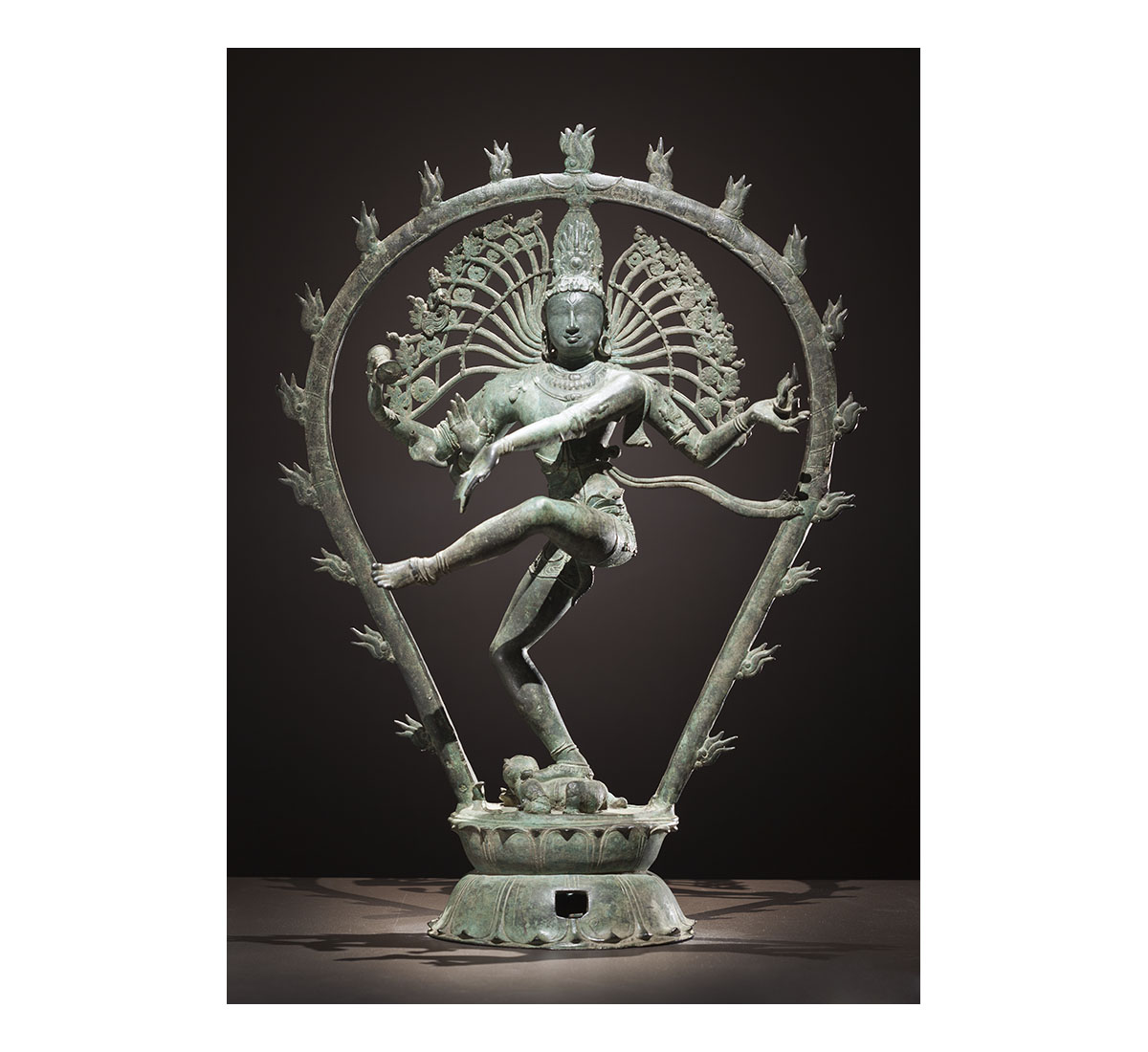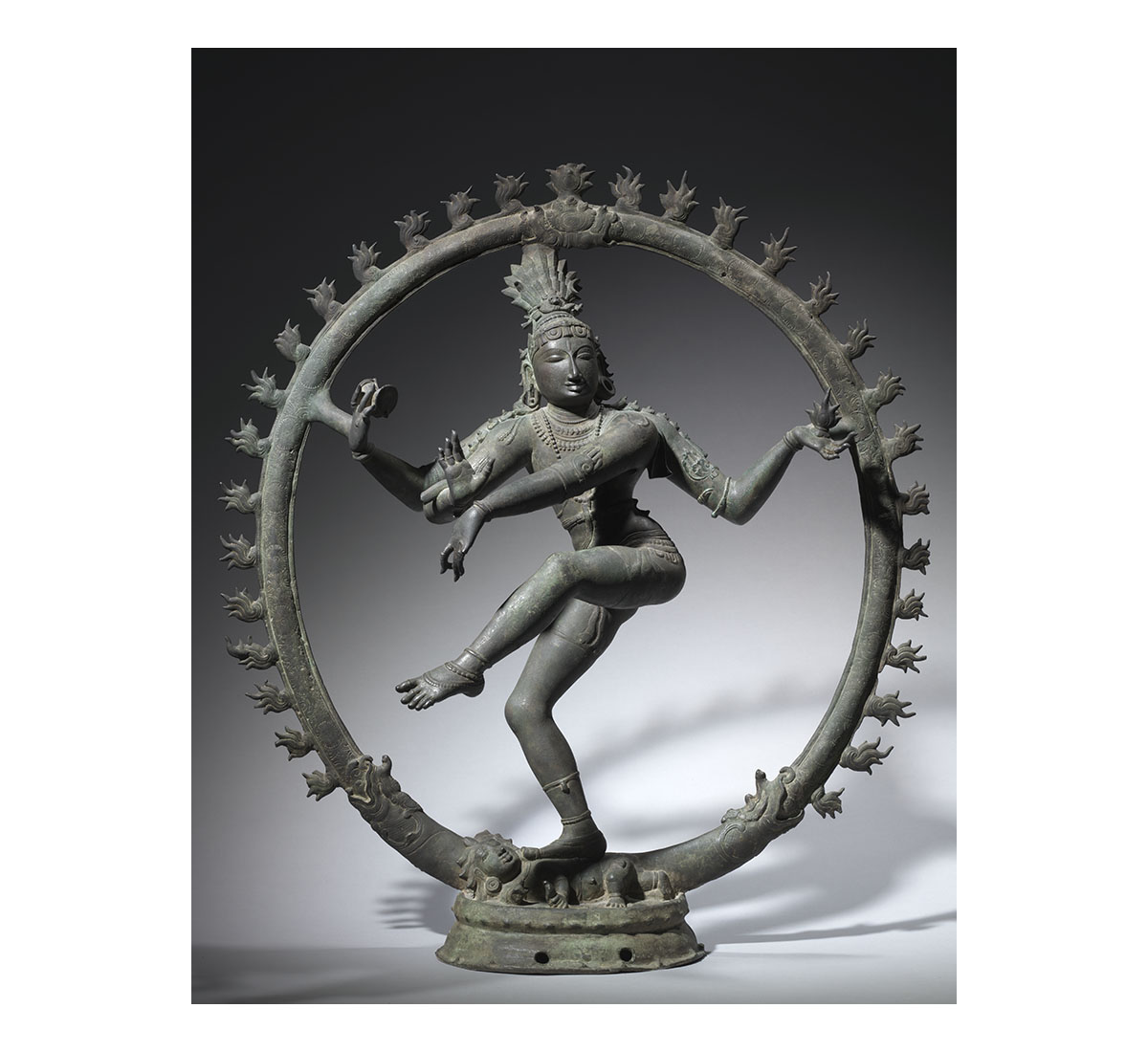ARTICLE
Chola Natarajas
Bronze sculptures produced from the tenth to the thirteenth centuries CE in the regions corresponding to present-day Tamil Nadu, Chola Natarajas depict a four-armed Shiva performing either the anandatandava (the dance of bliss) or the nadanta (the dance of destruction).
Chola Natarajas generally depict the god standing within a ring of flames, with the rear right hand holding a damaru drum, while the rear left hand grasps a cobra or a flame. The palm of the front right hand faces the devotee in the abhaya mudra, assuring them of freedom from fear; the left arm crosses the body in a gajahasta or dandahasta. The god’s right leg is placed upon an apasmara purusha, a dwarf representing ignorance. The left leg is raised across the body.
Shiva was represented in bronze and stone sculpture in Tamil Nadu from the seventh–eighth centuries CE. These traditions were developed and homogenised in the tenth century, when the then-emerging Chola Dynasty began to patronise the Shaiva temple at Chidambaram, the seat of a cult of the dancing Shiva. The bronze sculptures produced through this patronage had a slimmer waist and limbs than earlier examples from the region; the deity was also given a meditative, serene expression. The figures were buoyant in their modelling, with the god appearing to be lifted with the lightness of the dance. In earlier sculptures, the flaming ring surrounding Nataraja was elliptical and emerged from the mouths of two makaras on either side of the figure’s base. By the eleventh century, the halo became completely circular in shape. This icon became tremendously popular in Tamil Nadu until the thirteenth century, with patrons from a variety of backgrounds commissioning Natarajas in bronze, stone and in murals. These depictions suggest a close relationship between dance, religion and visual arts such as painting and sculpture in mediaeval South Asia.
After their discovery by academics in the nineteenth century, Chola Natarajas gradually became among the most well-known examples of South Asian art. They have been studied for their aesthetic and artistic sophistication as well as their possible metaphorical meaning. A highly influential interpretation was put forward by Ananda K. Coomaraswamy, who argued that the Nataraja represents the five principal activities of Shiva: srishti (creation), sthiti (preservation), samhara (destruction), tirobhava (illusion, rest) and anugraha (salvation). The dance of Shiva was thus seen as representative of the beginning and end of all creation, as well as the transcendence of the self through the grace of the god. Coomaraswamy’s interpretation led to widespread interest in Nataraja; the dancer Uday Shankar and the art historian Alice Boner extensively studied and interpreted this form in their work. However, recent scholarship has challenged interpretations such as Coomaraswamy’s, pointing out that there are few contemporary sources discussing the meaning of the Nataraja figures and how they were perceived in their own time.
Numerous examples of Chola Natarajas survive to this date, with many of them still in the temples that they were originally donated to. One of the most significant examples is still actively worshipped at the Brihadeshwara or Rajarajeshvara Temple in Thanjavur, Tamil Nadu, built by the Chola king Rajaraja I in the eleventh century. The sculpture is one of sixty-six figures that were donated to the temple by Rajaraja I and his son Rajendra I. Other notable collections that house Chola Natarajas are the Metropolitan Museum of Art, New York; the Museum van Asiatische Kunst, Rijksmuseum, Amsterdam; the British Museum, London; and the National Museum, New Delhi.
Bibliography
Our website is currently undergoing maintenance and re-design, due to which we have had to take down some of our bibliographies. While these will be re-published shortly, you can request references for specific articles by writing to hellomapacademy@map-india.org.









